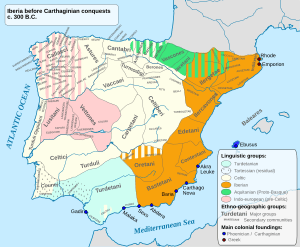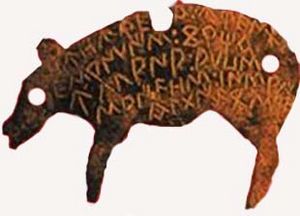Arevaci facts for kids
The Arevaci were a Celtic people who lived in the central part of Hispania (modern-day Spain). They were very powerful in a region called Celtiberia from about 400 BC to the late 100s BC. The Vaccaei people were their friends and allies.
Contents
Where the Arevaci Came From
The Arevaci were part of a larger group of Celtic people known as the Celtiberians. There is lots of proof that the ancestors of the Celtiberians lived in the central plateau of the Iberian peninsula as early as 1000 BC.
Some historians think the Arevaci's ancestors were early Celtic speakers from Gaul (modern-day France). They might have moved to the Iberian Peninsula around 550 BC. This was about the same time as the strong Vaccaei people arrived in the western part of the plateau. Because of this, some people believe the Arevaci were a branch of the Vaccaei. Their name, "Are-Vaccei," could mean "eastern Vacceians."
However, the Roman writer Pliny the Elder had a different idea. He called them Celtiberi Arevaci and said their name came from the Areva river (now called Araviana). So, their name could mean "those who live by the Areva river."
Where the Arevaci Lived
The main area where the Arevaci lived was in what are now the provinces of Soria and most of Guadalajara. Their land also stretched into eastern Segovia and southeastern Burgos. For a while, they also controlled parts of the nearby Zaragoza province.
They built or took over several important cities in northern Celtiberia. Some of these were:
- Clunia (near Coruña del Conde – Burgos)
- Voluce/Veluka (around Calatañazor – Soria)
- Uxama Argelae (near Osma – Soria)
- Termantia (Montejo de Tiermes – Soria), also called Termes
- Numantia (near Garray – Soria)
Other towns like Segovia and Ocilis are mentioned in old writings, but their exact locations are not yet known.
Arevaci Culture
The Arevaci shared a similar way of life with the Vaccaei. They often shared resources and worked together. While the Vaccaei were good at farming wheat, the Arevaci mainly raised animals. They moved their animals to different pastures, especially in the lowlands of the upper Ebro valley.
They raised sheep (mostly for their wool), horses, and oxen. For example, in 139 BC, the Roman leader Quintus Aulus Pompeius made the cities of Numantia and Termantia pay a large amount. They paid with 3,000 ox-hides, 800 horses, and 9,000 woollen cloaks.
Religion and Customs
The Arevaci had a special custom for their dead warriors. They would leave the bodies of warriors killed in battle for vultures. This practice is described by ancient writers like Silius Italicus and Claudius Aelianus. We also see evidence of this on grave markers and painted pottery found in Numantia.
Arevaci History
The Greeks and Romans saw the Arevaci as the most warlike people of the eastern plateau. The historian Herodotus said they started trying to take over more land early on. In the 400s BC, they joined other Celtic groups like the Lusones and Vaccaei to settle in the southwest of the Iberian Peninsula.
However, in the late 300s and early 200s BC, the Arevaci changed direction. They expanded east towards the upper Duero river and south into the central mountains. Here, they took over land from the Pellendones people. They conquered the towns of Savia and Numantia and made the Uraci people part of their territory. This gave them control over important towns like Aregrada, Cortona, Segontia (Sigüenza), and Arcobriga.
Around the mid-200s BC, the Arevaci formed a group of tribes with their neighbors, the Lusones, Belli, and Titii. This group was called the Celtiberian confederacy, and Numantia was its main city.
During the Second Punic War (a big war between Rome and Carthage), the Celtiberian confederacy stayed neutral. However, Celtiberian soldiers who fought for money (mercenaries) are mentioned fighting for both sides. The first Roman attack into the Celtiberian lands happened around 195 BC. The Roman leader Cato the Elder tried to attack Seguntia Celtiberorum and Numantia but was not successful.
The Arevaci and the Belli later fought against Roman rule in the Celtiberian War.
When Numantia fell in 134-133 BC, the Romans forced the Celtiberian confederacy to break up. They allowed the Pellendones and Uraci to become independent from the Arevaci again. The Arevaci were now officially part of the Roman province of Hispania Citerior.
Even so, the remaining Arevaci cities still had strong armies. Led by Clunia and Termantia, they helped defend Celtiberia from attacks by the Lusitani in 114 BC and the Cimbri around 104-103 BC. The Arevaci were proud of these successes but felt Rome didn't appreciate their efforts. So, they started planning secretly against Roman rule. They encouraged other unhappy Celtiberian neighbors to join uprisings from 99-81 BC. However, the Roman leader Titus Didius crushed the Arevaci in 93-92 BC. Their new capital, Termantia, and the city of Colenda were destroyed around 98-94 BC.
Becoming Roman
Even after officially becoming part of Hispania Citerior after 93 BC, the Arevaci's relationship with Rome was difficult. During the Sertorian War, the Arevaci supported Quintus Sertorius and sent soldiers to his army. They continued to resist Roman ways and rules for many decades. This, along with unfair taxes, led to occasional outbreaks of violence even into the 1st century AD.
In 29 BC, the Arevaci did send a cavalry unit (a group of horse soldiers) called the Ala Hispanorum Aravacorum to fight with the Roman legions in the first Astur-Cantabrian war. However, the historian Tacitus says that heavy taxes were the main reason for a revolt in the Termes region. This revolt led to the ambush and killing of Lucius Calpurnius Piso, a Roman governor, in 25 AD.
See also
 In Spanish: Arévacos para niños
In Spanish: Arévacos para niños
- Astur-Cantabrian war
- Celtiberian confederacy
- Celtiberian script
- Celtiberian Wars
- Numantine War
- Pre-Roman peoples of the Iberian Peninsula




